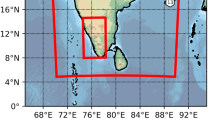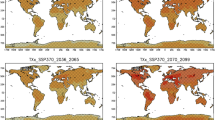Abstract
The present study examines the ability of the forecast (WRF) model to reproduce a heavy rainfall flash-flood event that hit the urban area of Skopje City, on August 6, 2016. A series of numerical experiments were carried out to evaluate the model’s performance in the simulation of this catastrophic event, which caused great material damage and the loss of 23 human lives. The simulations with the triple-nested WRF-ARW runs as well as the experiment using WRF-NMM dynamic core with the initial data of FNL GDAS showed better skills in a more precise qualitative and quantitative assessment of the total 24-h accumulated precipitation, the location and the relative intensities of rainfall. Explicit treatment of convection without parameterization significantly improves forecast accuracy and reduces forecast errors. The verification results, using standard tests, showed the model’s ability to reproduce the occurred flood. The correlation coefficient is higher for runs with explicit cumulus convection and 4 km resolution with the Yonsei PBL scheme and Thomson microphysics with aerosol climatology. In addition to the influence of the thermodynamic characteristics of the atmosphere, orographic forcing on the development of a strong mesosystem is of great importance for the intensification of convective cells and the production of large amounts of precipitation.








Similar content being viewed by others
References
Bernadet LR, Grasso LD, Nachamkin JE, Finley CA, Cotton WR (2000) Simulating convective events using a high-resolution mesoscale model. J Geophys Res 105(14):963–982
Chang HI, Kumar A, Niyogi D, Mohanty U, Chen F, Dudhia J (2009) The role of land surface processes on the mesoscale simulation of the July 26, 2005, heavy rain event over Mumbai, India. Glob Planet Change 67:87–103
Chawla I, Osuri KK, Mujumdar PP, Niyogi D (2018) Assessment of the Weather Research and Forecasting (WRF) model for simulation of extreme rainfall events in the upper Ganga Basin. Hydrol Earth Syst Sci 22:1095–1117
Chinta S, Yaswanth SJ, Balaji C (2021) Assessment of WRF model parameter sensitivity for high-intensity precipitation events during the Indian summer monsoon. Earth Space Sci 8(6). https://doi.org/10.1029/2020ea001471
Cluckie ID, Han D (2000) Fluvial flood forecasting. Water Environ J 14(4):270–276
Ćurić M, Janc D (2011a) Comparison of modeled and observed accumulated convective precipitation in mountainous and flat land areas. J Hydrometeorol 12:245–261. https://doi.org/10.1175/2010JHM1259.1
Ćurić M, Janc D (2011b) Analysis of predicted and observed accumulated convective precipitation in the area with frequent split storms. Hydrol Earth Syst Sci 15:3651–3658. https://doi.org/10.5194/hessd-8-7237-2011
Dudhia J (1989) Numerical study of convection observed during the Winter Monsoon Experiment using a mesoscale two-dimensional model. J Atmos Sci 46:3077–3107
Elmore KL, Stensrud DJ, Crawford KC (2002) Ensemble cloud model applications to forecasting Thunderstorms. J Appl Meteorol Climatol 41:363–383. https://doi.org/10.1175/1520-0450(2002)041<0363:ECMATF>2.0.CO;2
Ferrier B (1994) A double-moment multiple-phase four-class bulk ice scheme. Part 1: Description. J Atmos Sci 51(2):249
Gao Y, Leung LR, Zhao C, Hagos S (2017) Sensitivity of U.S. summer precipitation to model resolution and convective parameterizations across gray zone resolutions. J Geophys Res Atmos 122:2714–2733
Gevorgyan A (2018) Convection-permitting simulation of a heavy rainfall event in Armenia using the WRF model. J Geophys Res Atmos 123:11008–11029
Han JY, Hong SY (2018) Precipitation forecast experiments using the Weather Research and Forecasting (WRF) model at gray-zone resolutions. Weather Forecast 33:1605–1616
Hong SY, Lee JW (2009) Assessment of the WRF model in reproducing a flash-flood heavy rainfall event over Korea. Atmos Res 93:818–831
Hong SY, Lim JOJ (2006) The WRF single-moment 6-class microphysics 515 scheme (WSM6). J Korean Meteorol Soc 42:129–151
Janjic ZI (1996) The surface layer in the NCEP Eta Model. Eleventh Conference on Numerical Weather Prediction, 19–23 August, Norfolk, VA, American Meteorological Society, Boston, pp 354–355
Janjic ZI (2002) Nonsingular Implementation of the Mellor–Yamada Level 2.5 Scheme in the NCEP Meso model. National Centres for Environmental Prediction (NCEP), Camp Springs, p 61
Janjic ZI (2003) A nonhydrostatic model based on a new approach. Meteorol Atmos Phys 82:271–285
Jankov I, Gallus WA Jr, Segal M, Koch SE (2007) Influence of initial conditions on the WRF–894 ARW model QPF response to physical parameterization changes. Weather Forecast 22(3):501–519
Jee JB, Kim S (2017) Sensitivity study on high-resolution WRF precipitation forecast for a heavy rainfall event. Atmosphere 8:96
Kain JS, Weiss SJ, Levit JJ, Baldwin ME, Bright DR (2006) Examination of convection-allowing configurations of the WRF-NMM model for the prediction of severe convective weather: the SPC/NSSL Spring Program 2004. Weather Forecast 21:167–181
Kumar A, Dudhia J, Rotunno R, Niyogib D, Mohanty UC (2008) Analysis of the 26 July 2005 heavy rain event over Mumbai, India using the Weather Research and Forecasting (WRF) model. Q J R Meteorol Soc 134:1897–1910
Lee JW, Hong SY (2006) A numerical simulation study of orographic effects for a heavy rainfall event over Korea using the WRF model. Atmosphere 16:319–332
Lee TY, Kim YH (2007) Heavy precipitation systems over the Korean peninsula and their classification. J Korean Meteorol Soc 43:367–396
Lee DK, Kim HR, Hong SY (1998) Heavy rainfall over Korea during 1980–1990. Korean J Atmos Sci 1:32–50
Lekhadiya HS, Jana RK (2018) Analysis of extreme rainfall events with different microphysics and parameterization schemes in the WRF model. Positioning 9:1–11
Levit JJ, Baldwin ME, Bright DR (2006) Examination of convective allowing configurations of the WRF-NMM model for the prediction of severe convective weather: the SPC/NSSL spring program 2004. Weather Forecast 21:167–181
Litta AJ, Mary IS, Mohanty UC, Kiran PS (2012) Comparison of thunderstorm simulations from WRF-NMM and WRF-ARW models over East Indian Region. Sci World J 2012:951870
Liu Y, Chen Y, Chen O, Wang J, Zhuo L, Rico-Ramirez MA, Han D (2021) To develop a progressive multimetric configuration optimisation method for WRF simulations of extreme rainfall events over Egypt. J Hydrol 598:126237
Lompar M, Ćurić M, Romanic D (2017) Simulation of a severe convective storm using a numerical model with explicitly incorporated aerosols. Atmos Res 194:164–177
Lompar M, Ćurić M, Romanic D (2018) Implementation of a gust front head collapse scheme in the WRF numerical model. Atmos Res 203:231–245. https://doi.org/10.1016/j.atmosres.2017.12.018
Merino A, García-Ortega E, Navarro A, Sánchez JL, Tapiador FJ (2022) WRF hourly evaluation for extreme precipitation events. Atmos Res 274:106215
Misenis C, Zhang Y (2010) An examination of the sensitivity of WRF/Chem predictions to physical parameterizations, horizontal grid spacing, and nesting options. Atmos Res 97:315–334
Mlawer EJ, Taubman SJ, Brown PD, Iacono MJ, Clough SA (1997) Radiative transfer for inhomogeneous atmospheres: RRTM, a validated correlated-k model for the longwave. J Geophys Res 102D:16663–16682. https://doi.org/10.1029/97JD00237
Mohanty U, Routray A, Osuri KK, Prasad SK (2012) A study on simulation of heavy rainfall events over Indian region with ARW-3DVAR modeling system. Pure Appl Geophys 169:381–399
Moya AS, Martínez-Castro D, Flores JL, Silva Y (2018) Sensitivity study on the influence of parameterization schemes in WRF_ARW model on short- and medium-range precipitation forecasts in the Central Andes of Peru. Adv Meteorol 2018:1–16. https://doi.org/10.1155/2018/1381092
Schwartz C, Glen R, Ryan S, Fossell K, Weisman M (2015) NCAR’s experimental real-time convection-allowing ensemble prediction system. Weather Forecast 30:150904135422005. https://doi.org/10.1175/WAF-D-15-0103.1
Shin HH, Hong SY (2011) Intercomparison of planetary boundary-layer parametrizations in the WRF model for a single day from CASES-99. Bound Layer Meteorol 139:261–281
Shin H, Hong SY (2015) Representation of the subgrid-scale turbulent transport in convective boundary layers at gray-zone resolutions. Mon Weather Rev 143:250–271
Skamarock WC, Klemp JB (2008a) A time-split non-hydrostatic atmospheric model for weather 938 research and forecasting applications. J Comput Phys 227(7):3465–3485
Skamarock WC, Klemp JB (2008b) A time-split nonhydrostatic atmospheric model for weather research and forecasting applications. J Comput Phys 227:3465–3485. https://doi.org/10.1016/j.jcp.2007.01.037
Skamarock WC, Weisman ML, Klemp JB (1994) Three-dimensional evolution of simulated long-lived squall lines. J Atmos Sci 51:2563–2584
Skamarock WC, Klemp JB, Dudhia J et al (2008a) A description of the advanced research WRF version 3 (No. NCAR/TN-475+STR). University Corporation for Atmospheric Research. https://doi.org/10.5065/D68S4MVH
Skamarock WC, Klemp JB, Dudhia J, Gill DO, Barker D, Duda MG, Powers J (2008) A Description of the Advanced Research WRF Version 3 (no. NCAR/TN-475+ STR). University Corporation for Atmospheric Research
Sofiati I, Nurlatifah A (2019) The prediction of rainfall events using the WRF (weather research and forecasting) model with ensemble technique. Int Conf Ser Earth Environ Sci 374:12036
Song HJ, Sohn BJ (2018) An evaluation of WRF microphysics schemes for simulating the warm-type heavy rain over the Korean Peninsula. J Atmos Sci 54(2):225–236
Spiridonov V, Ćurić M (2019) Evaluation of Supercell storm triggering factors based on a cloud resolving model simulation. Asia Pac J Atmos Sci 55:439–458
Spiridonov V, Baez J, Telenta JB (2020) Prediction of extreme convective rainfall intensities using a free-running 3-D sub-km-scale cloud model initialized from WRF km-scale NWP forecasts. J Atmos Solar-Terr Phys 209:105401. https://doi.org/10.1016/j.jastp.2020.105401
Spiridonov V, Ćurić M, Grcic M, Jakimovski B (2022) Ensemble cloud model application in simulating the catastrophic heavy rainfall event. J Atmos Sci Res 5(4). https://doi.org/10.30564/jasr.v5i4.5081
Sun J, Lee TY (2002) A numerical study of an intense quasi-stationary convection band over the Korean Peninsula. J Meteorol Soc Jpn 80:1221–1245
Sun C, Liang XZ (2020) Improving US extreme precipitation simulation: sensitivity to physics parameterizations. Clim Dyn 54(11–12):4891–4918
Sun J, Xue M, Wilson JW, Zawadzki I, Ballard SP, Onvlee-Hooimeyer J (2014) Use of NWP for nowcasting convective precipitation recent progress and challenges. Bull Am Meteor Soc 95(3):409–426
Thompson G, Eidhammer T (2014) A study of aerosol impacts on clouds and precipitation development in a large winter cyclone. J Atmos Sci 71(10):3636–3658. https://doi.org/10.1175/JAS-D-13-0305.1
Thompson G, Field PR, Rasmussen RM, Hall WD (2008) Explicit forecasts of winter precipitation using an improved bulk microphysics scheme. Part II: Implementation of a new snow parameterization. Mon Weather Rev 136:5095–5511
Umer Y, Ettema J, Jetten V, Steeneveld GJ, Ronda R (2021) Evaluation of the WRF model to simulate a high-intensity rainfall event over Kampala Uganda. Water 13:873
Weisman ML, Davis C, Wang W, Manning KW, Klemp JB (2008) Experiences with 0–36 h Explicit convective forecasts with the WRFARW model. Weather Forecast 23:407–437
Wilson JW, Roberts RD (2006) Summary of Convective storm initiation and during IHOP: observational and modeling perspective. Mon Weather Rev 134:23–47
Xue M, Kong F, Thomas KW, Gao J, Wang Y, Brewster K, Droegemeier KK, Kain JS, Bright SJDR, Coniglio MC, Du J (2008) CAPS real-time storm-scale ensemble and high-resolution forecasts as part of the NOAA Hazardous Weather Testbed 2008 Spring Experiment. In: Preprints, 24th conference on severe local storms, Amer. Meteor. Soc., Savannah, GA. CD-ROM 12.2
Xue M, Martin WJ (2006) A high-resolution modeling study of the 24 May 2002 dryline case during IHOP. Part I: numerical simulation and the dryline’s general evolution and convection evolution. Mon Weather Rev 134:149–171
Zhang DL, Gao K, Parsons DB (1989) Numerical simulation of an intense squall line during 10–11 June 1985 PRE-STORM. Part I: model verification. Mon Weather Rev 117:960–994
Zheng Y, Xue M, Li B, Chen J, Tao Z (2016) Spatial characteristics of extreme rainfall over China with hourly through 24-hour accumulation periods based on national-level hourly rain gauge data. Adv Atmos Sci 33:1218–1232
Acknowledgements
We would like to acknowledge Ms. Nina Aleksovska from the Hydrometeorological Service of Macedonia (NMHS) for providing precipitation data and daily rainfall distribution for this case study event. We very much appreciate the efforts of the editor and the anonymous reviewers for their devoted time, valuable review, and very useful and constructive recommendations.
Author information
Authors and Affiliations
Corresponding author
Ethics declarations
Conflict of interest
On behalf of all authors, the corresponding author states that there is no conflict of interest.
Additional information
Edited by Prof. Theodore Karacostas (CO-EDITOR-IN-CHIEF).
Rights and permissions
Springer Nature or its licensor (e.g. a society or other partner) holds exclusive rights to this article under a publishing agreement with the author(s) or other rightsholder(s); author self-archiving of the accepted manuscript version of this article is solely governed by the terms of such publishing agreement and applicable law.
About this article
Cite this article
Spiridonov, V., Ćurić, M., Grčić, M. et al. Assessment of the WRF model in simulating a catastrophic flash flood. Acta Geophys. 71, 1347–1359 (2023). https://doi.org/10.1007/s11600-023-01032-5
Received:
Accepted:
Published:
Issue Date:
DOI: https://doi.org/10.1007/s11600-023-01032-5




